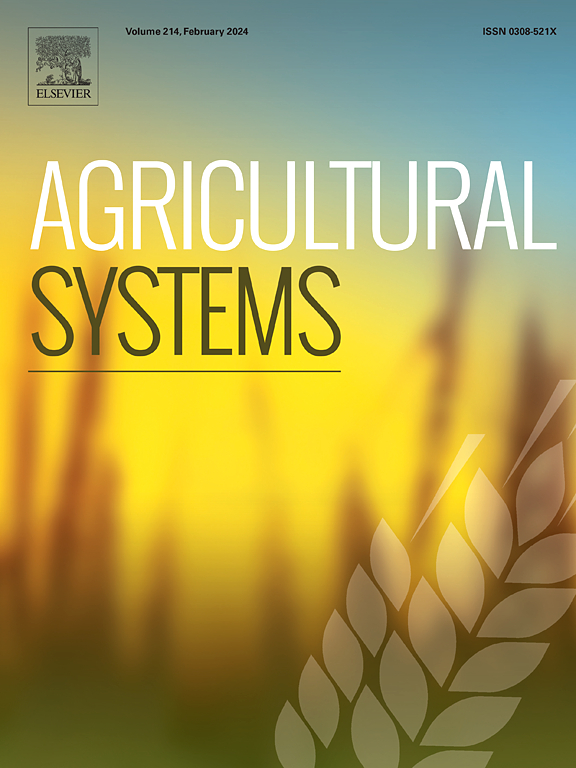评估阿富汗巴米扬旱地作物制图和农民战略的多维方法
IF 6.1
1区 农林科学
Q1 AGRICULTURE, MULTIDISCIPLINARY
引用次数: 0
摘要
全球变暖对农业的影响有据可查,但农民面临的多重挑战,特别是水资源方面的挑战,仍然知之甚少。尽管进行了大量的科学研究,但像阿富汗这样营养不良程度仍然很高的地区,仍然需要深入调查气候趋势与农业之间的相互作用。与全球许多干旱农业地区类似,阿富汗的农业系统已经因过度使用地下水和气候模式变化导致的干旱频率增加而遭受枯竭。因此,阿富汗迫切需要利用现有数据集开展气候趋势和适应策略的跨学科研究,因为粮食安全是阿富汗短期内需要解决的最关键挑战之一。本研究旨在用一种整体的方法解释阿富汗农民目前面临的与他们的农业战略相关的挑战——特别是他们的作物选择及其背后的原因——以及气候变化对水资源的影响。在通过访谈和遥感描述作物选择、农业实践及其相关挑战之后,我们的目标是使用CORDEX模型,特别是针对阿富汗北部的缩减模型,来分析农业关键气候变量的未来预测。我们的目标是强调未来的挑战,并制定建议,以改善农业系统对气候变化的适应。方法利用Sentinel-2遥感影像进行作物制图,量化农户的作物选择。根据《农田快速分类指南》和2023年生长季地面收集的作物类型数据,使用谷歌Earth Engine进行分类。除了遥感量化外,我们还对农民进行了深入访谈,以了解他们在农业系统中面临的经济和气候压力。虽然作物图显示了每种作物类型的面积,但它并没有揭示作物选择背后的重要社会经济原因。为了提取农业关键气候变量的百年趋势,我们使用了世界气候研究计划的协调区域缩减实验(CORDEX-CORE)的预测结果,并根据阿富汗的当地情况进行了调整。选取具有代表性的浓度路径8.5和2.6分别描述了未来一个世纪最乐观和最悲观的温室气体排放情景。结果和结论:农民主要种植马铃薯(52%),其次是小麦(37%)和苜蓿(11%),总体精度为83%。根据他们的采访,家庭生计和盈利能力是他们选择作物的主要原因,历史气候趋势和干旱对农民的农业战略没有显著影响。由于对水资源的大量使用,种植土豆等有利可图的作物已经导致地下水位在过去30年里显著下降了13米。因此,马铃薯的单一栽培对当地水资源来说是不可持续的。气候预测表明,在RCP 2.6和RCP 8.5情景下,极端降水没有显著变化,但未来一个世纪该地区的高温日数有明显增加的趋势。超过25°C和30°C的天数将增加,从而延长生长季节并提高温度。同时,预计在此期间土壤湿度将下降,这可能对产量和生产力造成影响。本研究对气候变化对阿富汗农业实践和水资源的影响进行了全面分析。通过整合卫星图像、农民访谈和气候预测,研究结果为可持续农业战略提供了重要见解,并强调了在气温上升和水资源短缺的情况下迫切需要采取适应性措施以确保粮食安全。本文章由计算机程序翻译,如有差异,请以英文原文为准。

A multi-dimensional approach to assess crop mapping and farmer strategies in drylands of Bamyan, Afghanistan
Context
Global warming's impacts on agriculture are well-documented, yet the multiple challenges farmers face, particularly regarding water resources, remain poorly understood. Despite substantial scientific research, regions like Afghanistan, where the level of undernourishment remains very high, still require in-depth investigations into the interactions between climate trends and agriculture. Similar to many arid agricultural regions globally, Afghanistan's agricultural systems have already suffered from depleted groundwater levels due to overuse and increasing drought frequencies due to shifting climate patterns. Therefore, interdisciplinary research on climate trends and adaptive strategies using available datasets is urgently needed in Afghanistan, where food security is one of the most critical challenges to address in the short term.
Objectives
This study aims to explain the current challenges faced by Afghan farmers related to their agricultural strategies - specifically, their crop choices and the reasons behind them - and the impacts of climate change on water resources using a holistic approach. After characterizing the crop choices, the agricultural practices and their related challenges using interviews and remote sensing, we aim to use CORDEX models, specifically downscaled for Northern Afghanistan, to analyze future predictions of key climate variables for agriculture. Our goal is to highlight future challenges and formulate recommendations to improve the adaptation of agricultural systems to climate change.
Methods
We applied crop mapping using Sentinel-2 imagery to quantify farmers' crop choices. Classification was performed using Google Earth Engine, following the Rapid Classification of Croplands instructions and ground-collected crop type data during the growing season in 2023. Along with remote sensing quantification, we conducted in-depth interviews with farmers to understand the economic and climate pressures they face in their agricultural systems. While the crop map shows the area for each crop type, it does not reveal the significant socio-economic reasons behind crop selection. To extract century-long trends of key climate variables for agriculture, we used projections from the World Climate Research Programme's Coordinated Regional Downscaling Experiment (CORDEX-CORE), adjusted to the local context of Afghanistan. Representative Concentration Pathways 8.5 and 2.6 were selected to illustrate the most optimistic and pessimistic greenhouse gas emission scenarios for the coming century.
Results and conclusions
Farmers predominantly cultivate potatoes (52 %), followed by wheat (37 %) and alfalfa (11 %), based on a crop map with an overall accuracy of 83 %. Family subsistence and profitability are the main reasons for their crop choices, and historical climate trends and droughts did not significantly influence the agricultural strategies of farmers, according to their interviews. The cultivation of profitable crops like potatoes has led to a significant drawdown of the groundwater level by 13 m over three decades due to the more intense use of water resources. Consequently, the monoculture of potatoes is unsustainable for local water resources. Climate predictions do not indicate significant changes in extreme precipitation under either RCP 2.6 or RCP 8.5 scenarios, but there is a noticeable trend of increasing heat days in the region over the next century. The number of days above 25 °C and 30 °C will rise, extending the growing season and raising temperatures. Concurrently, soil moisture is expected to decrease during this period, with possible consequences on the yields and productivity.
Significance
In this study was conducted a holistic analysis of the impacts of climate change on agricultural practices and water resources in Afghanistan. By integrating satellite imagery, farmer interviews, and climate projections, the findings provide crucial insights into sustainable farming strategies and highlights the urgent need for adaptive measures to ensure food security in the face of rising temperatures and water scarcity.
求助全文
通过发布文献求助,成功后即可免费获取论文全文。
去求助
来源期刊

Agricultural Systems
农林科学-农业综合
CiteScore
13.30
自引率
7.60%
发文量
174
审稿时长
30 days
期刊介绍:
Agricultural Systems is an international journal that deals with interactions - among the components of agricultural systems, among hierarchical levels of agricultural systems, between agricultural and other land use systems, and between agricultural systems and their natural, social and economic environments.
The scope includes the development and application of systems analysis methodologies in the following areas:
Systems approaches in the sustainable intensification of agriculture; pathways for sustainable intensification; crop-livestock integration; farm-level resource allocation; quantification of benefits and trade-offs at farm to landscape levels; integrative, participatory and dynamic modelling approaches for qualitative and quantitative assessments of agricultural systems and decision making;
The interactions between agricultural and non-agricultural landscapes; the multiple services of agricultural systems; food security and the environment;
Global change and adaptation science; transformational adaptations as driven by changes in climate, policy, values and attitudes influencing the design of farming systems;
Development and application of farming systems design tools and methods for impact, scenario and case study analysis; managing the complexities of dynamic agricultural systems; innovation systems and multi stakeholder arrangements that support or promote change and (or) inform policy decisions.
 求助内容:
求助内容: 应助结果提醒方式:
应助结果提醒方式:


